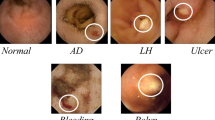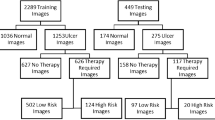Abstract
Cancer is a difficult disease and one of the leading causes of human mortality. There are various types of cancers associated with various parts of human anatomy. Among all cancer-related deaths, gastrointestinal (GI) cancers like esophageal, stomach, and colorectal cancer have significantly higher mortality rates. There can be a great reduction in mortality if these pre-cancerous lesions are detected and removed in earlier stages. Manual methods for cancer detection are painful and time-consuming. Video has been used as a means of detection for this type of cancer. However, video having many frames requires a lot of human effort for better analysis and is prone to the wrong diagnosis at a greater level. Automatic intelligent detection and classification help in the reduction of the death rate among cancer patients. This also can assist experts in better diagnosis and treatment. This paper presents a novel framework for the automated classification of ulcers using the WCE image KVASIR dataset. First, preprocessing is done to enhance the contrast, which improves the classification task. Well-known deep learning models ResNet50 and ResNet152-V2 are trained using preprocessed data and trained features are extracted. These features are fused using concatenation. These combined features are optimized using modified GA. The optimal number of features is then used for classification and an accuracy of 99.67 has been achieved. Results are compared with current state-of-the-art techniques and the proposed method has performed better in terms of improved accuracy.








Similar content being viewed by others
Data availability
No specific data is available for this work.
References
Alaskar H, Hussain A, Al-Aseem N, Liatsis P, Al-Jumeily D (2019) Application of convolutional neural networks for automated ulcer detection in wireless capsule endoscopy images. Sensors 19(6):1265
Alwazzan MJ, Ismael MA, Ahmed AN (2021) A Hybrid algorithm to enhance colour retinal fundus images using a wiener filter and CLAHE, J Digital Imaging pp 1–10.
Amin J, Sharif M, Gul E, Nayak RS (2021) 3D-semantic segmentation and classification of stomach infections using uncertainty aware deep neural networks, Complex Intell Syst pp 1–17
Bray F, Ferlay J, Soerjomataram I, Siegel RL, Torre LA, Jemal A Global cancer statistics 2018: GLOBOCAN estimates of incidence and mortality worldwide for 36 cancers in 185 countries, CA: a cancer journal for clinicians, vol. 68, no. 6, pp 394–424, 2018.
Ellahyani A, Jaafari IE, Charfi S, Ansari ME (2021) Detection of abnormalities in wireless capsule endoscopy based on extreme learning machine. Signal Image Video Process 15(5):877–884
Fan S, Xu L, Fan Y, Wei K, Li L (2018) Computer-aided detection of small intestinal ulcer and erosion in wireless capsule endoscopy images, Phys Med Biol 63(16):165001.
Fraz MM, Basit A, Barman SA (2013) Application of morphological bit planes in retinal blood vessel extraction. J Dig Imaging 26(2):274–286
Halevy A, Norvig P, Pereira F (2009) The unreasonable effectiveness of data. IEEE Intell Syst 24(2):8–12
Haralick RM, Sternberg SR, Zhuang X (1982) Image analysis and mathematical morphology, IEEE transactions on pattern analysis and machine intelligence, 4:532–550.
Husain S, Ahmed AR, Johnson J, Boss T, O’Malley W (2007) CT scan diagnosis of bleeding peptic ulcer after gastric bypass. Obe Surg 17(11):1520–1522
Iddan G, Meron G, Glukhovsky A, Swain P (2000) Wireless capsule endoscopy. Nature 405(6785):417–417
Kaplan GG (2017) Does breathing polluted air increase the risk of upper gastrointestinal bleeding from peptic ulcer disease? The Lancet Planetary Health 1(2):e54–e55
Khan MA, Rashid M, Sharif M, Javed K, Akram T (2019) Classification of gastrointestinal diseases of stomach from WCE using improved saliency-based method and discriminant features selection. Multimedia Tools Appl 78(19):27743–27770
Khan SA, Hussain S, Yang S (2020a) Contrast enhancement of low-contrast medical images using modified contrast limited adaptive histogram equalization. J Med Imaging Health Inform 10(8):1795–1803
Khan MA, Javed K, Khan SA, Saba T, Habib U, Khan JA, Abbasi AA (2020b) Human action recognition using fusion of multiview and deep features: an application to video surveillance. Multimedia Tools Appl pp 1–27.
Levin B, Lieberman DA, McFarland B, Andrews KS, Brooks D, Bond J, Dash C, Giardiello FM, Glick S, Johnson DJG (2008) Screening and surveillance for the early detection of colorectal cancer and adenomatous polyps, 2008: a joint guideline from the American Cancer Society, the US Multi-Society Task Force on Colorectal Cancer, and the American College of Radiology. Gastroenterology 134(5):1570–1595
Li B, Meng MQ (2009) Computer-based detection of bleeding and ulcer in wireless capsule endoscopy images by chromaticity moments. Comput Biol Med 39(2):141–147
Liao M, Zhao Y-Q, Wang X-H, Dai PS (2014) Retinal vessel enhancement based on multi-scale top-hat transformation and histogram fitting stretching. Opt Laser Technol 58:56–62
Liaqat A, Khan MA, Shah JH, Sharif M, Yasmin M, Fernandes SL (2018) Automated ulcer and bleeding classification from WCE images using multiple features fusion and selection. J Mech Med Biol 18(04):1850038
Mohapatra S, Nayak J, Mishra M, Pati GK, Naik B, Swarnkar T Wavelet Transform and Deep Convolutional Neural Network-Based Smart Healthcare System for Gastrointestinal Disease Detection, Interdisciplinary Sciences: Computational Life Sciences, pp 1–17, 2021.
Naz J, Sharif M, Raza M, Shah JH, Yasmin M, Kadry S, Vimal S (2021) Recognizing Gastrointestinal Malignancies on WCE and CCE Images by an Ensemble of Deep and Handcrafted Features with Entropy and PCA Based Features Optimization, Neural Process Lett pp 1–26.
Pizer SM, Amburn EP, Austin JD, Cromartie R, Geselowitz A, Greer T, ter Haar Romeny B, Zimmerman JB, Zuiderveld K Adaptive histogram equalization and its variations, Computer vision, graphics, and image processing, vol. 39, no. 3, pp 355–368, 1987.
Pogorelov K, Randel KR, Griwodz C, Eskeland SL, de Lange T, Johansen D, Spampinato C, Dang-Nguyen D-T, Lux M (2017) Schmidt PT Kvasir: A multi-class image dataset for computer aided gastrointestinal disease detection. Proc 8th ACM Multimedia Syst Conf, pp 164–169.
Qi X Computer-aided diagnosis of early cancers in the gastrointestinal tract using optical coherence tomography Case Western Reserve University, 2008.
Rathnamala S, Jenicka S (2021) Automated bleeding detection in wireless capsule endoscopy images based on color feature extraction from Gaussian mixture model superpixels. Med Biol Eng Comput 59(4):969–987
Rehman A Ulcer Recognition based on 6-Layers Deep Convolutional Neural Network. Proceedings of the 2020 9th International Conference on Software and Information Engineering (ICSIE), 2020, pp 97–101.
Shcherbatenko MK, Selina IE, Chekalina MI (1996) X-ray diagnosis features of acute bleeding ulcers of the stomach and duodenum. Vestn Rentgenol Radiol 3:25–28
Shorten C, Khoshgoftaar TM (2019) A survey on image data augmentation for deep learning. J Big Data 6(1):1–48
Souaidi M, Abdelouahed AA, El Ansari M (2019) Multi-scale completed local binary patterns for ulcer detection in wireless capsule endoscopy images. Multimedia Tools Appl 78(10):13091–13108
Sun C, Shrivastava A, Singh S, Gupta A (2017) Revisiting unreasonable effectiveness of data in deep learning era. Proc IEEE Inte Conf Comput Vis, pp 843–852.
Sun JY, Lee SW, Kang MC, Kim SW, Kim SY, Ko SJ A novel gastric ulcer differentiation system using convolutional neural networks. 2018 IEEE 31st International Symposium on Computer-Based Medical Systems (CBMS). IEEE, 2018, pp 351–356
Vani V, Prashanth KM Ulcer detection in Wireless Capsule Endoscopy images using deep CNN, Journal of King Saud University-Computer and Information Sciences, 2020.
Wang W, Wang W, Hu Z (2019b) Segmenting retinal vessels with revised top-bottom-hat transformation and flattening of minimum circumscribed ellipse. Med Biol Eng Compu 57(7):1481–1496
Wang H, Wang L, Lee EH, Zheng J, Zhang W, Halabi S, Liu C, Deng K, Song J, Yeom KW (2021) Decoding COVID-19 pneumonia: comparison of deep learning and radiomics CT image signatures. Eurox J Nucl Med Mol Imaging 48(5):1478–1486
Wang S, Xing Y, Zhang L, Gao H, Zhang H (2019a) Deep convolutional neural network for ulcer recognition in wireless capsule endoscopy: experimental feasibility and optimization, Comput Math Methods Med 2019a.
Wang S, Xing Y, Zhang L, Gao H, Zhang H (2019c) Second glance framework (secG): enhanced ulcer detection with deep learning on a large wireless capsule endoscopy dataset. Fourth International Workshop on Pattern Recognition (Vol. 11198, p 111980V). International Society for Optics and Photonics., 2019c, p 111980V.
Wang Z, Akande O, Poulos J, Li F Are deep learning models superior for missing data imputation in large surveys? Evidence from an empirical comparison, arXiv preprint arXiv:2103.09316, 2021.
Yang K, Chang S, Tian Z, Gao C, Du Y, Zhang X, Liu K, Meng J, Xue L (2022) Automatic polyp detection and segmentation using shuffle efficient channel attention network. Alexandria Eng J 61(1):917–926
Yasmeen U, Khan MA, Tariq U, Khan JA, Yar MAE, Hanif CA, Mey S, Nam Y (2021) Citrus diseases recognition using deep improved genetic algorithm. Comput Materials Continua 71(2):3667–3684
Yuan Y, Wang J, Li B, Meng MQ (2015) Saliency based ulcer detection for wireless capsule endoscopy diagnosis. IEEE Trans Med Imaging 34(10):2046–2057
Zhou M, Jin K, Wang S, Ye J, Qian D (2017) Color retinal image enhancement based on luminosity and contrast adjustment. IEEE Trans Biomed Eng 65(3):521–527
Acknowledgements
The authors extend their appreciation to the Deputyship for Research & Innovation, Ministry of Education in Saudi Arabia for funding this research work through the project number 8060.
Funding
The authors extend their appreciation to the Deputyship for Research & Innovation, Ministry of Education in Saudi Arabia for funding this research work through the project number 8060.
Author information
Authors and Affiliations
Corresponding author
Ethics declarations
Conflict of interest
The authors have no competing interests to declare that are relevant to the content of this article.
Additional information
Communicated by Irfan Uddin.
Publisher's Note
Springer Nature remains neutral with regard to jurisdictional claims in published maps and institutional affiliations.
Rights and permissions
About this article
Cite this article
Masmoudi, Y., Ramzan, M., Khan, S.A. et al. Optimal feature extraction and ulcer classification from WCE image data using deep learning. Soft Comput 26, 7979–7992 (2022). https://doi.org/10.1007/s00500-022-06900-8
Accepted:
Published:
Issue Date:
DOI: https://doi.org/10.1007/s00500-022-06900-8




